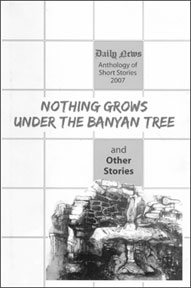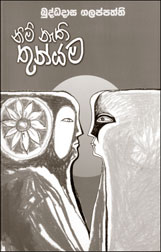|

A welcome addition to Sri Lankan English Literature
Reviewed by R. S.Karunaratne
"Nothing grows under the banyan tree and other stories"
"Daily News" Anthology of short stories 2007
Edited by Malini Govinnage
Annual Publications Department, ANCL
 Reviewing an anthology of short stories is more challenging than
commenting on a novel. In this anthology 24 writers lay bare stories
before the reader. I read them with great interest. But as usual some of
the short stories are highly readable and they demand the reader's
attention. Reviewing an anthology of short stories is more challenging than
commenting on a novel. In this anthology 24 writers lay bare stories
before the reader. I read them with great interest. But as usual some of
the short stories are highly readable and they demand the reader's
attention.
Short story writers create their own characters place them on their
own stage and make them act to some purpose. A good writer must present
his characters in action dramatising a fully realised theme. A good
example is Usula P. Wijesuriya's "Nothing grows under the banyan tree".
In this brilliant short story there are only two characters - Seela and
Ravi. We see a romance developing between a Sinhala girl and a Tamil
boy. But they do not go very far in their romance; they become victims
of circumstances. Those who are keen to solve the ethnic problem should
read this story to see the reality behind a false facade.
The action in a short story may depict violence, a lover's embrace or
a stream of consciousness. whatever form the action takes, its function
is to dramatise the event for the reader. Kamala Gunesekera's "The
shadow of she elephant rock" is about the insurgency and how innocent
villagers were brain- washed by the self-appointed liberators.
In some of his stories eminent writer Galsworthy had used a rather
slight, closed plot which runs the customary course of complication,
conflict, climax and denouement (resolution). He used plot and character
to reveal the theme. Nanda Jayakody in her short story "It's a day"
brings out the theme - loneliness in old age - through a closed plot. It
must be said to her credit that she has managed to sustain the reader's
curiosity right from the beginning to the end.
Patrick Jayasuriya's short story entitled "A sporting case" reminds
me of the Sathasivam murder case in which a well-known cricketer was
charged with killing his wife. However, he was not found guilty of the
murder. Here the narrator is a criminal lawyer named Pon Thyagaraja. To
make the story credible, the writer has established some authority
outside himself. The lawyer makes a representative truth of the author's
theme. It is a popular device to create a narrator whose point of view
controls the entire story.
Sheshadri Kottearachchi's "A heart unfinished" is a beautiful story
that evokes compassion for animals. To make us see things the writer
uses a blend of panorama and scene. The panorama gives us the
comprehensive and extensive view. The scene gives us the close up or
intensive view.
Art is not life; art recreates a phase of life for a specific
purpose. If the author fails to make it credible, all is lost. In some
of the stories in this anthology such credibility is lacking. If the
reader fails to feel the action almost simultaneously, the writer fails
in his duty. In Sharmini G. Rodrigo's "The mansion" there is a distance
between the reader and the action. As a result the reader finds it
difficult to contemplate on the intellectual content of the action.
Samanthi Wijeyeratne in "Little Bo" employs the method of summary to
tell the reader what happens in the story. Such a summary is valuable to
supply background information that the reader needs to know; for
instance, D. H. Lawrence used this method effectively in writing "The
rocking - horse winner".
He began his story with a summary: "There was a woman who was
beautiful, who started with all the advantages; yet she had no luck. She
married for love and the love turned to dust!" However, if you start
writing only summaries neglecting dramatic moments, its detailed scenes,
you fail as a short story writer.
Short story writers have to be patient and demanding self critics.
They should be able to step out of themselves and to inspect a story as
though with a reader's eyes. Some of the writers in this collection have
ignored this vital aspect of short story writing.
Space does not permit me to comment on all the short stories. Despite
drawbacks in some of the stories, the anthology is a welcome addition to
Sri Lankan English literature.
Journalists... A tribe apart
Reviewed By Neville Weereratne
Journalists are a tribe apart. They are, in the slogan of a wartime
newsreel, "the eyes and ears of the world". It is a highly responsible
task and members of this fraternity need to have a wholesome
appreciation of human nature, understand human foibles and exercise a
sense of justice that is beyond reproach if they are to make a real
contribution to the sum and total of human experience.
 Journalists are also able to wield power through sometimes subtle and
at other times obvious ways. They can influence the outcome of an
election, for example; they can persecute innocent people if they choose
to do that. It is, in the language of our times, an awesome
responsibility and to exercise that power with caution, sympathy and
understanding is the challenge that faces every member of the
profession. It surely illustrates the claim that "the pen is mightier
than the sword." Journalists are also able to wield power through sometimes subtle and
at other times obvious ways. They can influence the outcome of an
election, for example; they can persecute innocent people if they choose
to do that. It is, in the language of our times, an awesome
responsibility and to exercise that power with caution, sympathy and
understanding is the challenge that faces every member of the
profession. It surely illustrates the claim that "the pen is mightier
than the sword."
The author of The Serendib Spirit, a collection of delightful
bagatelles, is a journalist of the most irresistible kind. He has above
and beyond the demands of his profession a sense of humour with which he
soothes the human breast.
He allays the many fears that lurk in the minds of people, those dark
and dismal avatars that wait to spring on you when you least expect to
be found out, to be exposed to a polite society which pretends all the
while that there was nothing to hide, only to extol; that there are no
demons to exorcise, only angels to celebrate. The art of the journalist
depends entirely on its adherents' capacity to maintain a balance which
is simultaneously mystical and prophetic, light-hearted and deadly
serious.
When the journalist is encumbered with this great blessing or curse
(whichever is most apposite to the situation), try as you might, he
cannot be silenced; which explains how this book has come about. The
pieces in it are drawn from a column our feted journalist, Gaston de
Rosayro, contributed to one or other of the numerous newspapers on which
he has worked - in Sri Lanka and in Malaysia, in Singapore and Hong
Kong.
If you find traces of an irreverent mind in them, it is because the
reader himself has now been converted. He has become irreverent,
caustic, sharp, cynical like his mentor, but, and so much like his guru,
never uncharitable. This critic of our human nature has done nothing
more than hold up a mirror in which is reflected our passionate
pretences, our fraudulence, our silly games of make-believe.
If laughter is the best medicine, a little chuckle goes a long way
into appreciating our own uncertainties and inadequacies; and this is
where our author embarrasses us into recognising our own shortcomings
and lack of charity.
My first encounter with him was nearly forty years ago when he came
into the editorial department of the 'Ceylon Observer' where I was its
Features Editor. I marked him then for his zest - which was, indeed, the
prerogative of his youth. He was forever spouting a variety of notions
about the humorous, the mundane and the serious. He was bold and
infectious in his enthusiasms, good-natured most of the time, somewhat
excessive at others. In justification of his excesses you would enjoy
the energy of Gaston's writing.
He obtains his fun from a mercurial cast of mind and an extravagant
vocabulary. If you didn't know that the author was a distinguished
craftsman of the language, you would suspect, as I did at the beginning,
that he had a good dictionary and a well-thumbed thesaurus by his side.
But that would have been the ultimate fraud in itself and furthest from
the heart and mind of a totally committed journalist.
Words are, after all, are the stock-in-trade of every self-respecting
newspaperman. The test of excellence is in the capacity of the
practitioner to express himself without ambiguity, with a touch of wit,
with interesting turns of phrase that demand applause, focused all the
while on the perennial truths that govern our world if we would only
take the time to consider these aspects of living with due seriousness
and regard of their values.
It is just as easy, of course, to become overbearing and
condescending in the practice of this art. Beware, therefore, of false
prophets. I take up the task to offering Gaston de Rosayro this tribute
as a means of acknowledging him as a master of his craft, one endowed
with sharp, clear vision and sound hearing.
Today, some forty years later, you'll see that like Alexander Pope,
another master of another time, he "lisps in numbers for the numbers
come". He writes with great gusto and with an enviable fluency.
This talent with language in the different areas of newspaper
journalism has seen Gaston de Rosayro prospering in his chosen trade. If
I may change the metaphor, he has been engaged to play several roles -
features writer, sub-editor and editor; but it is a theatre upon which
the curtain never falls. Once you have entered this stage you became
heir to a burden that every journalist has to bear for the rest of his
days until, indeed, the final deadline is met. You cannot ever retire
from being the eyes and ears of the world. You are forever shackled to
the mirror that you must hold up in the hope of reflecting the truth.
Gaston has borne the yolk of editorial responsibility with all the
care and concern of the missionary and thereby earned the admiration and
applause of his readers and of his colleagues. To enjoy the confidence
of your reader is the journalist's greatest reward; to earn also the
respect of your colleagues is the highest tribute a journalist may hope
to achieve.
The pieces in this volume of essays come from different times and
different places, as I have said, but you'll see that they have not lost
their relevance since he plays upon the perennial human condition in
which, in all humility, he also finds himself.
These light and refreshing offerings will entertain today as they did
when they were first published. In book form, (to turn to another
metaphor), they are a handy means of dropping in for a quick draught of
refreshment of which you are invited to imbibe, or to savour the gourmet
tidbits he has laid temptingly before you.
Tidbits or a gourmet offering, sips of fine wines or large draughts,
either way a feast awaits you.
Bon app‚tit
Poetry of dissent back on the shelves
  The nineteen seventies was a notable era of the Sinhalese Poem.
During this decade there emerged three poets who stamped their mark in
the Sinhala poetic field. They are, Monica Ruwanpathirana, Parakrama
Kodituwakku and Buddhadasa Galappatty. The three of them simultaneously
brought out their debut collections of poems during the period. It was
the beginning of an era generally known as the age of people's poetry.
In 1972, Monica brought out "Thahanam Deshayakin" followed by "Obe
Yeheliya Eya Gehaniya" in 1975 and "Angulimalage Sihinaya" four years
later. The nineteen seventies was a notable era of the Sinhalese Poem.
During this decade there emerged three poets who stamped their mark in
the Sinhala poetic field. They are, Monica Ruwanpathirana, Parakrama
Kodituwakku and Buddhadasa Galappatty. The three of them simultaneously
brought out their debut collections of poems during the period. It was
the beginning of an era generally known as the age of people's poetry.
In 1972, Monica brought out "Thahanam Deshayakin" followed by "Obe
Yeheliya Eya Gehaniya" in 1975 and "Angulimalage Sihinaya" four years
later.
Parakrama Kodituwakku had his books of poems "Podi Malliye" and "Akeekaru
Putrayakuge Lokaya" published in 1973 and 1974 consecutively. Buddhadasa
Galappatty too had three collections of poems "Ketapath Pawra" in 1972,
"Para Wasa Etha" in 1974 and "Reginak Henduwaya" in 1976 during this
time.
Although some literary critics brand their work as "Poetry of
dissent" even today they are still popular among the readers, the
attraction being the warmth of the common man's life which exudes from
these poems.
Monica's untimely death a couple of years ago created a vacuum in Sri
Lankan poetry; nonetheless Parakrama and Buddhi have been carrying on
opening new vistas in the Sinhala poem. Two of them have come out with
their latest works.
The launch of Parakrama Kodituwakku's "Sansareta Mang Asai" and
Buddhadasa Galappatty's "Nim Nethi Thunyama" will take place at the Sri
Lanka Foundation Auditorium on January 18 Friday between 4 p.m. and 6.30
p.m. Ratna Sree Wijesinghe and Sunil Gunawardana (Poets) are billed to
address the gathering on the new books of the two poets. Critic Gaminee
Sumanasekara will be the compere.
The meeting will be chaired by Susil Siriwardane, who spearheaded the
cultural struggle in the seventies by starting the cultural publication
"Mawatha".
The People's Bank will sponsor the event which is open to the public.
The Wayfarer
"The Wayfarer" the maiden English novel of Professor Sunanda Mahendra,
is now on the shelves. The book is an attempt to express the innermost
feelings of a university don who is portrayed as a sensitive individual
torn between his home and the world at large. |
